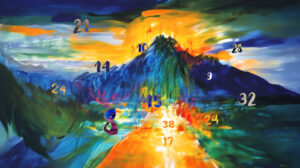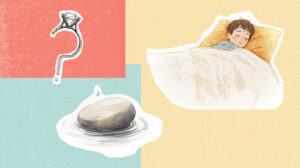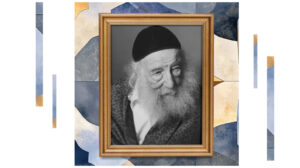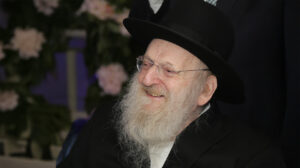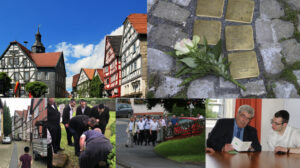More than Meets the Eye
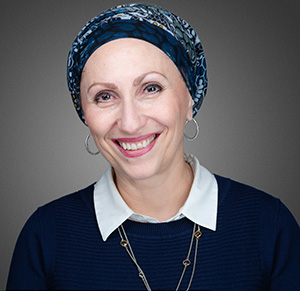
Legally blind, and living in the simplest of apartments, Naomi Adir is hardly your typical philanthropist. Yet over the decades she’s given hundreds of thousands of dollars to support Torah education.
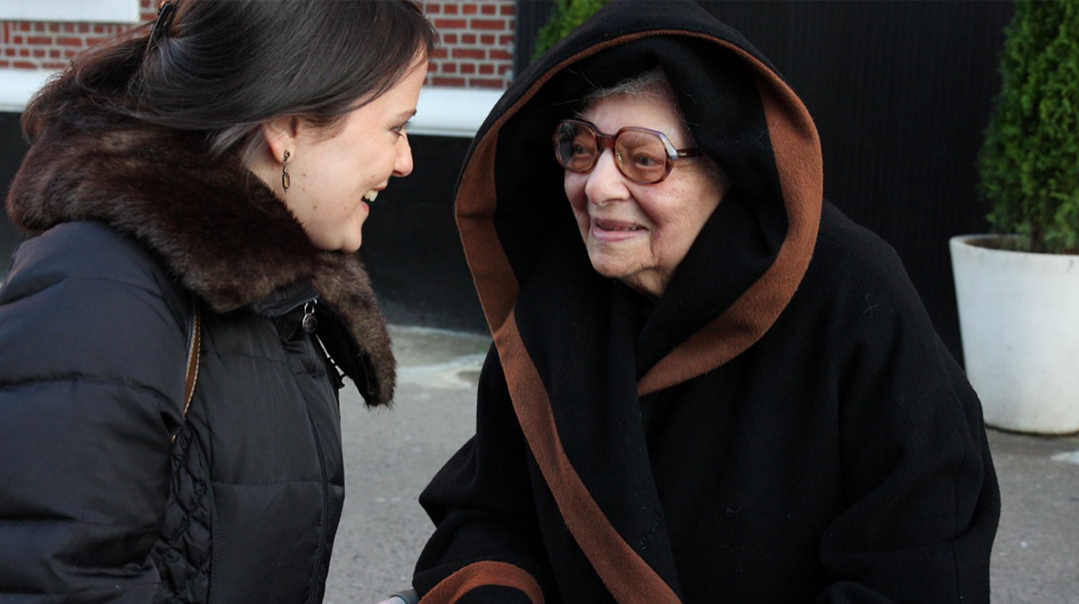
On December 2 1995 the New York Times published a small article in its Education section entitled “A Quiet Auditor Leaves Yeshiva a Fortune.” Anne Scheiber a single woman who had worked for the IRS and lived with acute frugality in a rent-controlled apartment had managed to coax a $5 000 nest egg into $22 million by the time of her death at age 101. While this was a feat that drew gasps of admiration from financial analysts even louder gasps were heard from Yeshiva University the day they got a call from Scheiber’s lawyer informing them she’d bequeathed it all to them.
When I first heard the Scheiber story I was convinced it was a once-in-a-century occurrence. But then just last week I met a woman who’s Anne Scheiber’s match — if not in millions then in generosity.
Naomi Adir now ninety-two lives alone in the Brooklyn apartment she once shared with her parents in the kind of absolute simplicity that characterizes many gedolim. Unlike Anne Scheiber Naomi made the choice over thirty years ago not to wait until 120 years to bestow the fruits of her investments on needy yeshivos.
Since 1979 this former public school teacher who has never seen fit to renovate her creaky apartment or replace her comfortable but scuffed shoes has been making the kind of yearly donations more typically offered by women wreathed in furs and diamonds. And unlike most other benefactors she doesn’t have the pleasure of beholding the results of her largesse in any of the usual ways: Naomi who has suffered from a visual impairment since young adulthood is almost totally blind.
Meeting Naomi
On a business block of Manhattan Beach, next to a row of attached houses with rickety front porches, sits a small, squat apartment building. A plaque next to the wrought iron door reads “Yeshiva and Mesivta of Manhattan Beach, Bais Shimon;” the building has been bought by a yeshivah that allows Naomi to retain her apartment here.
The door into the building leads to crooked marble steps. My knock on Naomi’s third-floor apartment is answered by a visiting friend.
Entering the apartment, I’m bowled over by a wave of bittersweet nostalgia for my grandmother’s apartment in the Bronx. Here are the same buckling wooden floors that creak under my steps, the same ancient appliances, the same dark armoires. Old metal milk crates hold vinyl records, next to cast-off school desks and a phonograph. I start to wonder if the brick passageway leading to the building was actually a time tunnel, whisking me back to the 1930s.
But there’s one striking difference from my grandmother’s apartment. The walls are covered with plaques, close to 125 of them: plaques from yeshivos and outreach organizations, from kindergartens and scholarship funds, from services for the blind, and many, many more, all honoring the contribution of Miss Naomi Ruth Adir in honor of Avraham Abba Haim and Rivka, her parents.
The apartment the surrounds me is ample testimony to the fact that Naomi has rarely spent a penny on herself. The plaques are ample testimony that she has spent hundreds of thousands of dollars on others.
The friend leads me to Naomi, who had a fall two days ago and is in bed nursing what she’s afraid may be a cracked rib. The waves of short white hair, the wide blue eyes, and the strong chin are also startlingly reminiscent of my grandmother.
Despite her obvious discomfort, Naomi welcomes me and we begin to speak.
A Life Devoted to Education
Naomi tells her story in a soft, unhurried tone, with the kind of directness and candor common to those who grew up amid yashrus and have nothing to hide. Her mind is so fresh and her voice so light one would never guess her real age from a phone conversation.
Naomi was born in 1918, and had a brother and a sister. Her father was a “customer peddler,” or installment dealer, and an insurance broker; her mother was home except for a brief period during the Depression when she helped supplement the family income by caring for an elderly lady. “But that was a shonda [disgrace] and we kept it quiet,” Naomi says. “Married women weren’t supposed to work in those days.”
Naomi remembers her father as active in shul and Jewish organizations, and her mother as an intelligent women whose interest in natural food and health put her ahead of her time (Naomi herself has been mostly vegetarian all her life, claiming she feels better that way). Her brother died at age eleven, which she remembers as “terribly painful for all of us.” She remained close to her sister, Judith, till her death in 1991.
Hanging prominently among the plaques on the walls are large sepia portraits of Naomi’s parents, grandparents, even a great-grandmother, Jews from Lithuania on her father’s side and Odessa from her mother’s. One old black-and-white photo shows a white-bearded man in front of a country house. “My grandfather was beaten in a pogrom during his youth,” Naomi explains, “and although he survived, he had trouble with his breathing the rest of his life. In the summer, he used to go to a kosher boardinghouse in Lakewood, because the air there was supposed to be good.”
The family originally moved to Brownsville, then a thriving Jewish neighborhood. One of their neighbors was the young Moshe Sherer, ztz”l. (“We didn’t know each other at the time,” she recounts. “I met him later, on a visit to Agudath Israel, and we talked — he was a brilliant man, a soft and gentle person.”)
Like most Jewish children in an era when yeshivos were few and far between, Naomi attended public schools, and then college, where she majored in biology. She worked for a while as a lab technician, and did a stint in a government office in Washington, DC, to aid the war effort.
But by early adulthood, a genetic eye impairment made lab work too difficult for Naomi. She saw an ad in a local paper seeking a girl to work in a nursery school. “I knew nothing about kids, and I had no experience,” she states. With characteristic frankness, she told her prospective employers as much. “They must have been desperate!” she grins. “They agreed to take me for two weeks on probation, and gave me six kids to work with.”
To her own great surprise and delight, she soon realized she’d found her calling. “I was very good at it, without any training!” she says proudly.
One day, however, she arrived at work to be called in to the director’s office, where two women from the Board of Health were waiting. “I thought, ‘Oh no, what have I done now?’Naomi says with a wry smile. But the problem was simply that regulations had changed, and it was now necessary to have a teaching degree. The state officials urged her to go back to school. “You’re a natural!” they said.
So Naomi began taking night classes at the prestigious Bank Street School, eating a sandwich for supper on the train after work. But her poor vision was still a problem. Hearing that NYU had classes that didn’t require as much reading, she transferred, and with the help of sympathetic teachers and helpful peers, earned her MA.
She was then thrilled to take a job directing a preschool; “just my thing,” she says. But the first paycheck was much less than what was initially promised, and the owners told her, “Take it or leave it.” She left it. “I didn’t want to deal with dishonest people,” she says flatly.
However, the hiring season was over for that school year. So Naomi took a test to be a substitute teacher, and began subbing in Harlem. Thus began a two-year substitute teacher career.
Naomi says she was naive and not particularly aggressive at the time. “I didn’t know the world,” she admits. “Somebody finally said to me, ‘Get a real job with the Board of Ed, with benefits!’ So I took the three-hour licensing test for elementary education [originally, she was only qualified for early childhood education]. It almost killed my eyes! And I had to get special glasses to pass the eye test on the physical, which I never wore again.”
Her visual impairment always felt like a “sword of Damocles,” hanging over her head. But in the thirty years she stayed with the Board of Education, no one suspected a thing. In fact, years later she participated in a panel at a luncheon for the Jewish Braille Institute at the Plaza Hotel, during which she mentioned that she had taught for years with a serious visual impairment. A New York Post reporter covering the luncheon turned her into a headline: “Teacher Is Blind and Nobody Knows It!” Today, her vision has completely deteriorated, but she says the fact that it happened gradually has helped her develop coping skills over time.
Naomi loved teaching, and was grateful for the opportunity to influence young minds. “Most of my teaching was done in the Bedford-Stuyvesant neighborhood,” she says. “It was a rough neighborhood even then. I’ve been bitten, kicked, and had chairs and scissors thrown at me. One day I was writing on the board and heard the kids yell, ‘Miss Adir! Miss Adir!’ I turned around and saw one of the kids hanging out of my second-story window, just his hands showing. Of course the principal always blamed me, but she also always gave me the hardest kids.”
Yet Naomi had a lot of success with them. Her first class, a sixth grade that included many who could barely read at a second-grade level, was initially uncontrollable. Then one day, she brought in some recordings of international music. She put on music and taught them a simple folk dance. “I developed a curriculum out of this,” she says. “They learned social studies through world music, and they settled down and learned.”
I ask if Naomi has any advice for teachers today. After a moment, she offers: “My way was to make them feel I was with them, on their side of the fence. Somehow I usually managed to say the right thing at the right time.”
Sometimes the “right thing” was communicated unwittingly, as when she once used the expression “turn over a new leaf” while explaining something. A boy in her class, who’d been known for fighting, stealing, and wild behavior, came to school the next day and sat himself quietly in his chair with his hands folded. “Miss Adir,” he told her gravely, “I’m turning over a new leaf!”
“And wouldn’t you know,” Naomi says, “for the rest of the year he was as good as gold!”
She does admit though that “a lot of my former students are probably in jail. Their mothers used to be jealous of the influence I had on their kids. But many of those mothers needed educating themselves!”
When asked what she thinks of education today, Naomi reflects. “I think we pour too much money into children who are uneducable, at the expense of gifted children,” she says frankly. “The Board of Ed is always asking for more money, but money isn’t the solution to education problems. The children have to be motivated to learn, and the teachers have to love to teach.”
The only “teaching” she does nowadays is to occasionally speak at yeshivos, teaching children about how to relate to a blind person. At one yeshivah, a rebbi flinched when she told him her talk lasts about an hour. “I can’t get them to sit still for twenty minutes,” he warned her. “Well,” Naomi reports triumphantly, “they sat spellbound for an hour and a half, and asked me superb questions.”
A teacher from Lakewood once brought her class of girls to visit Naomi, and Naomi seized the opportunity to try to impart the importance of frugality. “I tried to tell them that you can get by with very little,” she says. “You don’t need that extra pair of shoes to perfectly match your outfit. In my day, I’d put cardboard into my shoes when I got holes, because there was no money to buy new ones.” And she has the same message for parents. “Today, there are people who go on fancy trips, then don’t pay their tuition. People need to learn to conserve their funds; to make wise choices instead of spending money on naarischkeit. So many people don’t even hesitate before they plunk down money for things that aren’t necessary.”
Entering the World of Yeshivah Donations
Although Naomi is a free spirit who constantly changed her teaching to keep it fresh, and who spent decades in a secular professional world, her roots are firmly entrenched in her parents’ pious, strictly Orthodox home. “In those days, the idea of being ‘yeshivish’ didn’t exist,” she states. “Oh, I knew the names of a few prominent yeshivos because of my father, who was active in Jewish affairs. But I didn’t know anyone who went to a yeshivah.
“Sometimes my father would bring home eligible rabbis interviewing to work at the shul across the street from our house. But I always made myself scarce, because I couldn’t see myself living the life of a rebbetzin — it sounded too regimented for me. But wouldn’t you know, today so many of my good friends are rabbis and rebbetzins! I guess Hashem has a sense of humor.”
When Naomi retired, she began receiving her Board of Ed pension. As she was living with her parents, and naturally frugal, she continued to bank most of it. “Interest was high at the time, like 14 or 15 percent,” she recalls. “So the money accumulated.
“My father asked, ‘Why are you saving so much?’ and I said, ‘Well, I’m not married, and I want to have something put aside for my old age.’ My father told me, ‘Don’t worry. You’ll have Social Security checks and Medicare.’ So shortly after retirement, I began thinking how to give the money away.”
Her first thought was to give to the Jewish National Fund. But her father saw things differently. “That’s very nice,” he told her, “but things can happen to trees. But if you put your money into kids, and they learn, that knowledge won’t be forgotten.”
So Naomi switched her allegiance from trees to children. She had no particular affiliation to a shul or yeshivah, but she felt that Orthodox education was “the nucleus” of Am Yisrael. Her personal inclination was to give to kindergartens — “get them while they’re young,” as she puts it — and to schools in Israel, although she eventually branched out.
During this period, she visited a lawyer to draw up a will. “He was an Israeli lawyer who handled affairs for Israel in the US,” Naomi says. “When I told him I wanted to donate, he gave me five booklets with lists of organizations to choose from.” Her choices eventually included a yeshivah for boys in a drug-riddled section of Jerusalem’s Bukharian Quarter that had been turned around by a dynamic rabbi named Elbaz; the Chinuch Atzmai schools, where she was told that her donation that year, a whopping $50,000, had exceeded Reichmann’s; a yeshivah in the North whose name she doesn’t recall; and Aish HaTorah, which in 1979 had just thirteen boys.
“At the time I didn’t know to ask about numbers; all I knew was what Rabbi Weinberg was trying to do,” she says. “Fundgiving” visits brought her to Israel thirteen times.
Naomi wants to give me a tour of all her plaques. She gets out of bed with some difficulty, but after that she moves around pretty well with a walker, showing me photos and plaques though she herself is unable to see them. She points out a photo of a girls’ elementary school in Kiryat Arba, with a map of the world and a globe prominently displayed. “I went to visit the classroom and found the teacher giving a geography lesson without a map. I asked, ‘How can you teach geography with no map?’ My sister had given me $200 to donate in Israel, and I went out and bought that map and globe and a lot of other school supplies.”
While she originally planned to donate exclusively in Israel, a chance speech by a rabbi at an adult summer camp changed her mind. “We were sitting by the lake, and he said, ‘Jews shouldn’t put all their eggs in one basket.’ So then and there I decided to give in the US too.”
The lucky winner of her first American donation was Beth Medrash Govoha in Lakewood, where her father had donated money in Rav Aharon Kotler, ztz”l’s, time. Naomi sent them a postcard expressing her wish to donate, and, “Before I knew it, Rabbis Eli Hoberman and Nachum Barnetsky flew into my kitchen! Eli Hoberman took me to see BMG. I was astonished; I’d never seen anything like it. He took me to the second floor where I could look down and see the movement of hundreds of boys, the noise of their learning. This whole wall,” she says, indicating a grouping of plaques off her kitchen, “is all BMG.”
During that first Lakewood visit, Rebbetzin Rishel Kotler, the widow of Rav Schneur Kotler, ztz”l, made Naomi a small luncheon in her home, and Naomi subsequently spent many Shabbosim there. “We’re still friends,” Naomi says.
Over the years she’s made innumerable “marvelous friendships,” a wonderful dividend of her generosity. The more money she gave away, the richer she became in friends; she’s a regular Shabbos and Yom Tov guest in many of the most exalted Torah homes.
When word got around that a Miss Naomi Adir was giving generous one-time donations, yeshivos began contacting her. She ultimately gave to a staggering variety of yeshivos, from well-known Brooklyn institutions like Chaim Berlin, Torah Umesorah, P’eylim, and Torah Vodaath to yeshivos in Tuscon, Arizona, and South Bend, Indiana.
“I would come in cold and offer money,” she shrugs. “I didn’t research it, or ask how the money would be spent. I know a lot of businessmen who make donations want an accounting of where their dollars are being spent, but my goal was simply to give money where Orthodox Judaism was being maintained.” Her policy was to make a one-time donation, then ask the yeshivah “not to bother me again.” All of them, she says, were respectful of her wishes — that is, until last year, when many were so hard hit by the recession that they called her in desperation.
oHHShe shows me photos on her wall of herself, sometimes with her sister, being honored at yeshivah dinners. Naomi looks radiant, wearing elegant dresses that she tells me were “all secondhand — all borrowed.” In the beginning, she says, she felt it was “show-offy” to receive a plaque honoring her tzedakah. She would ask that plaques be engraved instead with the name of her parents or brother (and, after 1991, her sister). But as time went by, her thinking changed.
“You know, almost every plaque is in the name of a man, or a couple,” she says. “But there are many women out there with money, women who have worked all their lives, or inherited it. I thought if I put my name out there alone it might inspire other women to give.”
Today, there are school buses, conference rooms, and even a dance room in the girls’ division of Yeshiva Be’er Hagolah, complete with mirrored walls, ballets bars, and hardwood floors, sporting her name. She convinced one friend to donate $300,000 of her money to tzedakah, and another woman, equally rich, but “not as much of a giver,” to part with $35,000.
Taking Leave
It’s getting late, and Naomi needs to lie down again. She makes her way slowly back to her bed, and I help cover her, with a plaid woolen blanket covered by faded red floral sheets pinned together into a makeshift duvet cover. I’m a little worried about leaving her alone, but she reassures me that someone is coming in later. Meals are delivered by a Meals-On-Wheels organization, and she gets regular visits from friends and volunteers — during my visit, in fact, several people telephoned to schedule a visit.
Still, I feel loathe to leave Naomi alone in that very still, spare apartment, mostly confined to her bed, and with so little in the way of creature comforts. I offer to turn on a light in the darkening room, but she says it won’t make any difference to her till later, when she’ll turn it on herself.
“I feel very satisfied with my life,” she says meditatively as I prepare to leave, almost as if reassuring me. “I influenced many people through my teaching, and helped others be able to learn. That’s for eternity.”
I take her hand and squeeze it in parting. “Come visit again,” she urges. Suddenly it becomes clear to me why Naomi has such a loyal cadre of friends and volunteers who visit so often: she has the power, through her simplicity and sincerity, to touch people deeply. “I’ll do my best,” I promise.
Then, with a mysterious lump in my throat, I clatter down the narrow, crooked steps and head out into the bracing evening air.
(Originally featured in Family First, Issue 226)
Oops! We could not locate your form.

